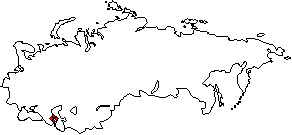CONTENTS
IntroductionForeword
Language Groups
Tribes and Dialects
Order the book
The Peoples
of the Red Book
Abazians (Abaza)Abkhaz
Aguls
Akhvakhs
Aleuts
Altaics
Aliutors
Andis
Archis
Asiatic Eskimos
Bagulals
Baraba Tatars
Bartangs
Bats
Bezhtas
Botlikhs
Budukhs
Central Asian Jews
Chamalals
Chukchis
Chulym Tatars
Crimean Jews
Crimean Tatars
Didos
Dolgans
Enets
Evens
Evenks
Georgian Jews
Godoberis
Hinukhs
Hunzibs
Ingrians
Ishkashmis
Itelmens
Izhorians
Kamas
Karaims
Karatas
Karelians
Kereks
Kets
Khakass
Khants
Khinalugs
Khufis
Khvarshis
Kola Lapps
Koryaks
Kryz
Kurds
Lithuanian Tatars
Livonians
Mansis
Mountain Jews
Nanais
Negidals
Nenets
Nganasans
Nivkhs
Nogays
Orochis
Oroks
Oroshoris
Peoples of the Pamirs
Roshanis
Rutuls
Selkups
Shors
Shughnis
Tabasarans
Talysh
Tats (Tatians)
Tindis
Tofalars
Trukhmens (Turkhmens)
Tsakhurs
Udeghes
Udis
Ulchis
Veps
Votes
Wakhs
Yaghnabis
Yazgulamis
Yukaghirs
visit the guestbook or mail comments to the webmaster

THE CHAMALALS
Their self-designation is chamalaldu, and they call their language chamalaldub mitchtch. The Chamalal language belongs to the Andi subgroup of the northwestern (Avar-Ando-Dido) group of Dagestan languages. In the genealogy of Dagestan languages, the closest to Chamalal are Bagulal and Tindi. An occasional influence from the Godoberi language is also discernible (in the Gigatl dialect). The Chamalal language is divided into two dialects -- the Gaquar dialect and the Gigatl dialect, with the former having the following subdialects: Upper-Gaquar, Lower-Gaquar, Quenkh and Gadór.
The Chamalals have no written language, and use the Avar language instead. The Chamalal language has been little researched. The first to pay attention to Chamalal as an independent linguistic unit were A. Dirr and R. Erckert in the late 19th century. More systematic research commenced only after World War II (A. Bokarev, Z. Magomedbekova).
The 1926 census noted the population of the Chamalals, but later they were counted as Avars. The following data comes from academics who have studied the Chamalals, and is approximate.
| 1926 | 3,438 |
| 1958 | 5,000 (J. Desheriyev) |
| 1967 | 4,000 (Z. Magomedbekova) |
Islam reached the Chamalal villages in the 8th--9th centuries following Arab conquests. Sunnite Islam began to spread further only in the 13th--14th centuries, and then it took a couple of centuries more to firmly take root. In the 8th century, Christianity also made an attempt to advance into the Chamalal territories from Georgia, but it was forced to retreat before Islam.
Anthropologically the Chamalals are related to the Caucasian type of the Balkano-Caucasian race. Features characteristic of the Caspian types (Lezgians) are also observable.
Ethnoculturally the Chamalals resemble the Avars, in a spiritual as well as a material sense. Minor differences in folk costume and traditions must be regarded as variations from a common cultural source, not principal divergences.
Historically the Chamalals have had much in common with the Avars and have been politically and economically associated with Avaria. There is no universal agreement on the origin of the Chamalals. It is supposed that such a tiny people could emerge only in circumstances of a prolonged isolation, but other hypotheses see the main reason as being the endogamous arrangement of the society, or the polystructural political system established in the Andi-Koisu river basin.
Since the 8th century, Avaria has been under foreign rule. From the 8th to the 14th centuries, it was the Maisum representing the Arab regime, from the 15th to the 18th centuries the Turks and Iranians displayed an aggressive interest in Avaria, and in the 19th century it was the Russians. Their supremacy was maintained until very recently. The rulers of Kakhetia have also, on occasion, cast their eye on the mountain areas of northwestern Avaria, most notably during the period when Georgia was a great power (12th--15th centuries). In the 16th century, 16 Chamalal villages formed a separate political unit, a "free community", which concentrated on management of the political and economic life of the Chamalals.
The nature of the Chamalal economy has been determined by the development of seasonal livestock-breeding. The main domestic animals were sheep, and, to a smaller extent, cattle and goats. Large-scale land cultivation was of no great importance because of the shortage of arable land. Agriculture on irrigated terraced fields attained a degree of success. The main crops were wheat and rye, and later, potatoes and vegetables, with flax and hemp as industrial crops. The yield was small. There was not enough grain to last the year round, and therefore additional stocks had to be bastered from the inhabitants of the Avarian plains.
On January 20, 1920, the Soviet regime was established in Dagestan. However, the struggle for real power lasted until the late 1930s. The mountainous area in southern Dagestan became the centre of active anti-Soviet resistance, where the White Guards, and Islamic and nationalist forces gathered. The Soviet regime retaliated with military might and deportations.
Alongside overt power politics, the central Soviet administration had to use more covert means to strengthen their regime, with its principal aim of transforming the social order and the psychology of the local populace. The new educational system was a tool to this end. As the Chamalals were considered too few to have their own written language, Avar was used for schooling. (The educational system is the same at the present time: during the first five years, classes are conducted in Avar, after that Russian takes over.) To offer an education to a small illiterate people is commendable, but it must be borne in mind that the ultimate aim was to repress the perception of national identity and character, and to restrain free thought.
REFERENCES
- R. Erckert, Die Sprachen des kaukasischen Stammes, Wien 1925
- П. А. Агларов, Сельская община в Нагорном Дагестане в ХVII -- начале ХIХ в., Москва 1988
- А. А. Бокарев, Очерки грамматики чамалинского языка, Москва -- Ленинград 1949
- Т. Е. Гудава, Консонантизм андийских языков (историко-сравнительный анализ), Тбилиси 1964
MK
asian_jews | chamalals | chukchis